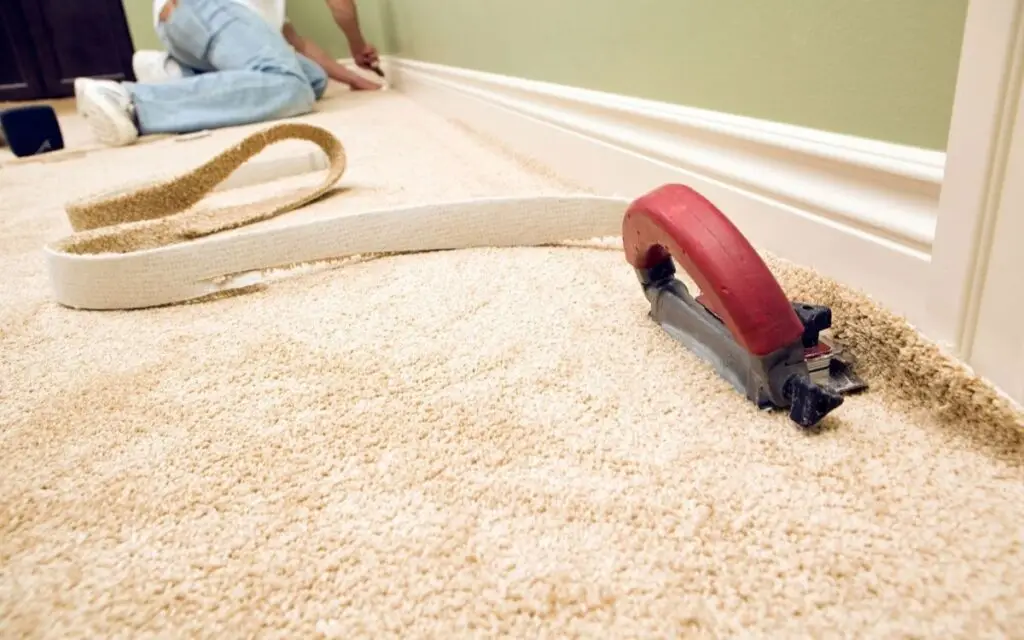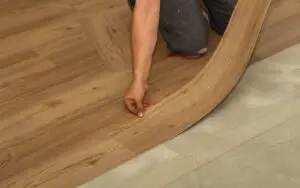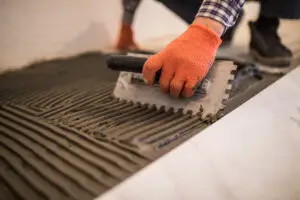What Affects Carpet Installation Time?
Room Size and Layout
The size of the room plays a significant role in determining how long carpet installation will take. Smaller rooms, such as bedrooms, are quicker to complete, while larger spaces like living rooms or open-plan areas require more time. Complex layouts with stairs, closets, or irregular shapes can also extend the installation process as they involve additional cutting, fitting, and precision work.
Type of Carpet and Underlay
The type of carpet chosen can impact installation time. For instance, patterned or textured carpets require careful alignment to ensure consistency, adding to the timeframe. Installing underlay beneath the carpet, which improves comfort and durability, also adds an extra step, especially if adjustments to fit the room are necessary.
Installation Method
The method used for carpet installation significantly influences timing:
- Stretch-In Installation: This popular method involves using a power stretcher and tack strips to secure the carpet, typically taking longer but offering a more durable finish.
- Glue-Down Installation: Faster than stretch-in, this method involves applying adhesive directly to the subfloor and is often used for commercial settings.
Preparation Before Installation
Removing Old Flooring
Removing existing carpet or other flooring types is a crucial step that adds time to the installation process. Tasks include cutting and rolling up the old material, removing staples or glue residue, and disposing of the debris. Depending on the size of the room and the state of the old flooring, this can add 1-3 hours or more.
Subfloor Inspection and Repairs
The subfloor must be clean, level, and dry before carpet installation. If cracks, moisture, or uneven areas are detected, repairs may be required, delaying the installation process.
Measuring and Ordering Carpet
Accurate measurements ensure the right amount of carpet is ordered, avoiding delays caused by insufficient materials. Delivery times, especially for custom or specialty carpets, may also affect the overall timeline.
Step-by-Step Carpet Installation Process
Step 1: Preparing the Room
Before installation, the room must be cleared of furniture and other obstructions. Baseboards may need to be removed to allow the carpet to fit properly against the walls. Vacuuming the subfloor ensures a clean surface.
Step 2: Installing Underlay
The underlay is measured, cut, and secured to the subfloor using tape or staples. This step provides cushioning and prolongs the carpet’s lifespan.
Step 3: Laying the Carpet
The carpet is unrolled and aligned with the room’s layout. Precision is crucial to ensure seams are minimized and patterns are consistent.
Step 4: Securing the Carpet
For stretch-in installations, a power stretcher or knee kicker is used to secure the carpet to tack strips along the edges. For glue-down methods, adhesive is applied, and the carpet is pressed into place.
Step 5: Finishing Touches
Excess carpet is trimmed, and baseboards or transitions are reinstalled to complete the look. A final inspection ensures the carpet is securely and evenly installed.
Average Timeframes for Carpet Installation
Standard Room Installations
A standard-sized room, such as a 12×12 bedroom, typically takes 2-4 hours for a professional installer to complete, assuming no major obstacles.
Larger Spaces and Complex Layouts
Larger rooms or spaces with complex layouts, such as stairs or landings, may require a full day or more. These areas involve additional cutting, fitting, and alignment to achieve a seamless look.
Same-Day Installations
For small rooms or spaces with minimal preparation, same-day installation is achievable. Proper preparation, such as clearing the room and addressing subfloor issues beforehand, is key to meeting this timeline.
DIY vs. Professional Carpet Installation
DIY Installation Time
For homeowners attempting a DIY carpet installation, the process can take significantly longer—up to a full day or more for a single room. Beginners often spend extra time learning techniques, making adjustments, and dealing with mistakes.
Professional Installation Efficiency
Professional installers are equipped with specialized tools and expertise, enabling them to complete installations quickly and accurately. They can handle complex layouts and large spaces efficiently, often finishing in half the time it would take a DIYer.
Factors That Can Delay Installation
Weather and Environment
High humidity or cold temperatures can affect the adhesive curing process in glue-down installations, potentially extending the timeframe.
Delivery or Stock Issues
Custom or specialty carpets may take longer to arrive, delaying the installation process.
Unexpected Subfloor Problems
Issues such as uneven surfaces, cracks, or moisture damage discovered during preparation may require repairs, adding hours or even days to the process.
Benefits of Hiring Professionals
Speed and Efficiency
Professionals complete installations efficiently, often handling multiple rooms in a single day. Their expertise ensures fewer delays and a quicker overall process.
Quality Assurance
With professional tools and techniques, installers achieve precise alignment, secure fitting, and a polished finish that ensures the carpet lasts for years.
Warranties and Guarantees
Many professional services offer warranties on workmanship, providing peace of mind and protection against potential issues.
FAQs & Answers
For an average-sized room (12x12), professional installers typically complete the job within 2-4 hours. Factors such as removing old flooring or installing underlay can add time to the process.
Yes, many installations can be done within a single day, especially for standard rooms with minimal preparation. Larger or more complex spaces may require additional time.
Yes, removing old carpet or other flooring can add 1-3 hours or more, depending on its condition and how securely it was installed.
Patterned or textured carpets may take longer to install due to the precision required for alignment. Simpler carpet types, like solid-color cut pile, are typically faster to work with.
Absolutely. Professionals have the tools, experience, and efficiency to complete the job quickly and correctly, often saving hours compared to DIY efforts.





